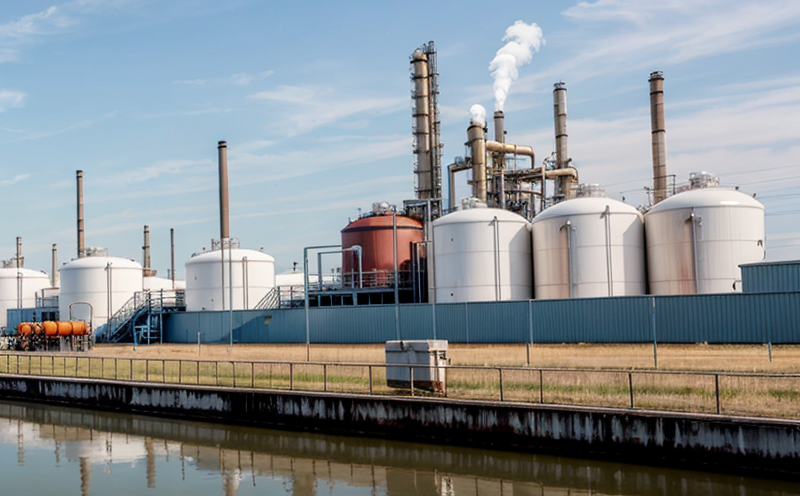ASTM D8482 Explosive Atmosphere Chemical Safety Testing
The ASTM D8482 standard provides a comprehensive framework for assessing the chemical safety of industrial substances that may contribute to explosive atmospheres. This service is crucial in industries dealing with flammable gases, vapors, or dusts where accidental ignition can lead to catastrophic consequences. Quality managers and compliance officers rely on this testing to ensure their products meet regulatory standards and safeguard worker health and plant integrity.
The ASTM D8482 test involves a series of procedures designed to identify the lower explosive limit (LEL) and upper explosive limit (UEL) for a given substance in an atmosphere under controlled conditions. This information is vital for industries such as petrochemicals, pharmaceuticals, and manufacturing, where the safe handling and storage of chemicals are paramount.
The testing process begins with thorough specimen preparation to ensure accurate results. Samples must be representative of the industrial chemical being tested, which can include pure substances or mixtures. The specimens undergo rigorous testing in a controlled environment that simulates real-world conditions as closely as possible.
One of the key aspects of ASTM D8482 is the use of specialized equipment designed to measure the limits at which an explosive atmosphere can form. This includes gas chromatography, mass spectrometry, and other analytical techniques. The instrumentation used in this testing ensures high precision and reliability, making it a critical component of industrial chemical safety.
The results of ASTM D8482 testing are used to define safe operating parameters for the storage and handling of chemicals. These limits inform the design of containment systems, ventilation requirements, and operational protocols. Understanding these limits helps prevent accidents that can lead to explosions, fires, or other hazardous events.
It is important to note that ASTM D8482 testing goes beyond simple chemical analysis; it also considers the physical properties of the substance, including its vapor pressure, ignition temperature, and reactivity with other chemicals. These factors are crucial in determining whether a given industrial chemical can contribute to an explosive atmosphere.
The process is not without challenges. Specimen preparation must be precise, as even small errors can lead to inaccurate results. Additionally, the controlled environment required for testing can be complex and expensive to maintain. However, the benefits of this rigorous testing far outweigh these challenges. By ensuring that industrial chemicals are handled safely, ASTM D8482 helps protect both people and property.
The significance of this service cannot be overstated in industries where explosive atmospheres pose a significant risk. The results of ASTM D8482 testing provide essential information for developing safety protocols and improving workplace practices. This service is not only about compliance with regulations but also about fostering a culture of safety within organizations.
In conclusion, ASTM D8482 Explosive Atmosphere Chemical Safety Testing is an indispensable tool in ensuring the safe handling of potentially hazardous chemicals. By providing accurate LEL and UEL values, this testing helps industries mitigate risks associated with explosive atmospheres. The detailed procedures outlined by ASTM ensure that every aspect of chemical safety is accounted for, making it a cornerstone of industrial safety practices.
Applied Standards
| Standard Name | Description |
|---|---|
| ASTM D8482-19 | This standard provides guidelines for the determination of lower explosive limits (LEL) and upper explosive limits (UEL) in industrial atmospheres. |
| ISO 6007-1:2015 | An international standard that complements ASTM D8482 by providing additional criteria for the safe handling of flammable gases. |
The application of these standards ensures consistency and reliability in testing, making it easier to compare results across different laboratories. Compliance with such standards also enhances confidence in the accuracy and safety of industrial practices.
Scope and Methodology
| Methodological Steps | Description |
|---|---|
| Sample Preparation | The specimen must be prepared under controlled conditions to ensure accuracy. |
| Testing Environment Setup | A controlled environment simulates real-world conditions as closely as possible. |
| Data Collection and Analysis | Instrumentation records the LEL and UEL values, which are then analyzed for compliance with standards. |
The methodology outlined in ASTM D8482 ensures that each step of the testing process is meticulously controlled to yield accurate results. This rigorous approach is essential for industries where even small errors could have catastrophic consequences.
International Acceptance and Recognition
- ASTM D8482 has been widely adopted by regulatory bodies in countries such as the United States, Canada, and various European Union member states.
- The standard is recognized for its comprehensive approach to assessing chemical safety in explosive atmospheres.
- International acceptance ensures that results from ASTM D8482 testing are valid across different jurisdictions.
This global recognition underscores the importance of this service in maintaining consistent standards worldwide. Regulatory authorities and industrial organizations rely on ASTM D8482 to ensure compliance with international safety protocols.





